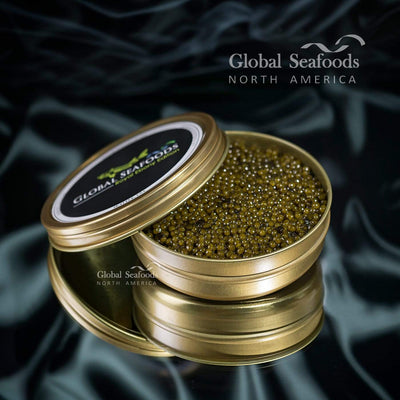Kaluga Caviar: The Ultimate Luxury Indulgence

Kaluga Caviar: The Ultimate Luxury Indulgence
Kaluga caviar, a decadent and luxurious delicacy, is often referred to as the “River Beluga” due to its similarity in taste and texture to the world-famous Beluga caviar. Prized for its large, glossy pearls and rich, buttery flavor, Kaluga caviar has become a favorite among food connoisseurs worldwide. But what makes this sturgeon caviar so special? In this comprehensive guide, we’ll explore everything you need to know about Kaluga caviar—its origins, harvesting methods, health benefits, and how it compares to other types of premium caviar.
For those looking to indulge in the finest Kaluga caviar, explore our Kaluga Caviar selection and other luxurious options like Beluga Caviar and Ossetra Sturgeon Caviar.
What is Kaluga Caviar?
Kaluga caviar is derived from the Kaluga sturgeon (Huso dauricus), a freshwater sturgeon species native to the Amur River basin. Known for its large, firm eggs and a taste profile similar to Beluga caviar, Kaluga caviar offers an unparalleled gourmet experience. The pearls of Kaluga caviar range in color from dark gray to light gold, offering a rich, creamy, and slightly briny flavor that melts in your mouth.
Taste and Texture of Kaluga Caviar
Kaluga caviar is renowned for its smooth, buttery texture, with eggs that pop gently on the palate, releasing a burst of flavor. It has a well-balanced umami taste with a hint of ocean brine, making it an ideal accompaniment to blinis, toast points, or eaten directly from the tin.
For more information on premium caviar options, check out our Ossetra Sturgeon Caviar and California White Sturgeon Caviar.
The Origins of Kaluga Caviar
Kaluga sturgeon are native to the Amur River, which forms the border between Russia and China. Historically, Kaluga caviar has been harvested from wild sturgeon, but due to overfishing and environmental concerns, sustainable aquaculture farms now produce most Kaluga caviar. These farms follow strict practices to protect the species and ensure that the highest quality caviar is produced in an environmentally responsible way.
According to The World Wildlife Fund, sustainable caviar farming is crucial to protecting endangered species like sturgeon. By choosing sustainably farmed Kaluga caviar, consumers are helping preserve this ancient fish for future generations.
Health Benefits of Kaluga Caviar
While Kaluga caviar is known for its indulgent taste, it also offers a variety of health benefits.
Rich in Omega-3 Fatty Acids
Caviar is one of the richest natural sources of omega-3 fatty acids, which are essential for heart health, brain function, and reducing inflammation. According to Harvard Medical School, a diet rich in omega-3s can lower the risk of cardiovascular disease and promote overall well-being.
High in Protein and Essential Nutrients
Kaluga caviar is also packed with high-quality protein, vitamins, and minerals, including Vitamin D, Vitamin B12, and selenium. These nutrients support immune function, boost energy levels, and help maintain healthy skin and bones.
For more health benefits, explore our collection of Sevruga Sturgeon Caviar and Paddlefish Caviar.
Kaluga Caviar vs. Beluga Caviar
While Kaluga and Beluga caviar share many similarities, there are key differences that set them apart.
Size and Appearance
Beluga caviar eggs are slightly larger than Kaluga eggs and have a more delicate membrane. Kaluga caviar tends to have a firmer texture and slightly darker pearls.
Taste Profile
Both caviars offer a rich, buttery flavor, but Kaluga caviar has a bolder, more robust taste with a hint of nuttiness. Beluga caviar is slightly more delicate, with a smooth, creamy texture.
Explore both varieties at Global Seafoods: Kaluga Caviar and Beluga Caviar.
How to Serve and Enjoy Kaluga Caviar
Kaluga caviar is best enjoyed chilled, served on a bed of ice, and paired with simple accompaniments that allow the flavor of the caviar to shine. Traditional pairings include:
- Blinis or toast points
- Crème fraîche or sour cream
- Hard-boiled eggs, minced onions, and fresh herbs
For the ultimate luxury experience, pair Kaluga caviar with Champagne or vodka to complement its rich, briny flavors.
Frequently Asked Questions About Kaluga Caviar
How Should I Store Kaluga Caviar?
Kaluga caviar should be stored in the coldest part of your refrigerator, ideally at temperatures between 28-32°F (-2-0°C). Once opened, it should be consumed within 3-5 days to ensure freshness and quality.
Can I Freeze Kaluga Caviar?
While it is possible to freeze caviar, it may affect the texture of the eggs. If you choose to freeze it, ensure the caviar is tightly sealed and stored for no more than a few months. Once thawed, consume it immediately to enjoy its best quality.
For more tips on storing and enjoying caviar, explore our Caviar Guide.
Also in News

How to Make Sea Bream Sushi With Dry-Aged Tuna & Crab Roll — Step-by-Step With Chef Joshua
A complete guide to making Sea Bream sushi at home, including filleting, curing, slicing, and building a Dry-Aged Tuna & Crab sushi roll. Chef Joshua shares professional tips for restaurant-quality results.

Boiled Crab for Game Night: Everything You Need for a Perfect Seafood Party
Take your game night to the next level with a Boiled crab party. Learn the best recipes, cooking tips, and hosting hacks for a memorable seafood feast.

Boiled Crab for Date Night: A Romantic Guide to the Perfect Seafood Feast
Make your next date night unforgettable with a romantic Boiled crab experience. This guide covers everything you need to know, from ambiance to the best crab varieties.

